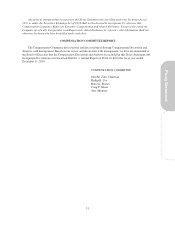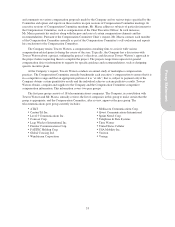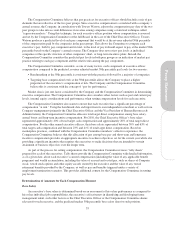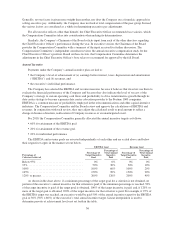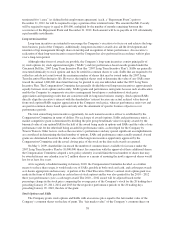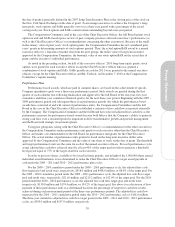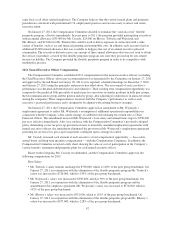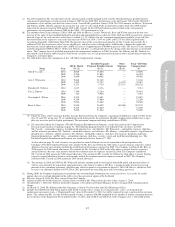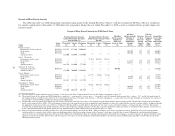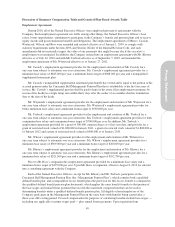Cincinnati Bell 2010 Annual Report Download - page 55
Download and view the complete annual report
Please find page 55 of the 2010 Cincinnati Bell annual report below. You can navigate through the pages in the report by either clicking on the pages listed below, or by using the keyword search tool below to find specific information within the annual report.
performance over a longer period. The Company and Compensation Committee believe the long term incentive
plans encourage good business decisions by the executive that consider the longer term strategy and needs of the
Company balanced against the demands of current year performance. Additionally, the plans provide a balance
between equity grants – either stock options or SARs – that are directly aligned with shareholder interests
because their value is a direct function of market share price, and a performance plan that is based on quantitative
Company results based on its ability to generate free cash flow, which can provide awards to balance the inherent
volatility of the stock market. Finally, as described above, the new Technology Solutions/Data Center Program
introduces an additional long term incentive to drive transformative growth in the Company’s Technology
Solutions/Data Center segment.
The Company applies its compensation policies and related decision-making process to the Chief Executive
Officer on the same basis as to the other named executive officers. Differences in pay levels for the Chief
Executive Officer relative to the other named executive officers is reflective of the additional responsibility,
knowledge, strategic judgment and leadership required of the Chief Executive Officer as compared to the other
named executive officers. The Compensation Committee believes the Chief Executive Officer’s pay is
reasonable when compared to market pay levels for other Chief Executive Officers at the revenue adjusted 50th
percentile combined with the Committee’s assessment of the Chief Executive Officer’s performance. Further, as
a percent of the telecommunications peer group “target” pay, the Chief Executive Officer’s pay is similar to that
of the other named executive officers of the Company.
The Company believes that its compensation program, taken as a whole, has been effective in attracting and
retaining key executive talent, driving attainment of its annual revenue and EBITDA goals, delivering sustained
cash flow performance over multiple years during a period of great economic disruption and industry
competition and aligning executive rewards with the interests of shareholders. The recent addition of the
Technology Solutions/Data Center Program will provide a significant incentive to drive transformative growth in
the Company’s Technology Solutions/Data Center segment over the next several years.
Benefits
Senior executives, hired prior to January 1, 2009, participate in the same pension plan as all other eligible
salaried and certain non-union hourly employees. The pension plan is a qualified defined benefit plan with a
nonqualified provision that applies to the extent that eligible earnings or benefits exceed the applicable Internal
Revenue Code limits for qualified plans. The Company makes all contributions to this plan. In addition, the Chief
Executive Officer is also covered under a nonqualified supplemental retirement plan, the Cincinnati Bell Pension
Program (“SERP”), the benefits of which are payable by the Company. Mr. Cassidy is vested in the SERP as he
has attained the age of 55 and has at least ten years of service. The SERP provides the Chief Executive Officer
with a benefit equal to 50% of the average of the highest 36 months of his compensation during his last five years
of employment. The calculated benefit is reduced for benefits payable from both the qualified defined benefit
plan and the nonqualified provision within such plan. Benefits under the SERP are also reduced if Mr. Cassidy
leaves the Company before the sum of his age and years of service total at least 75. The Company and the
Compensation Committee have determined that it is unlikely that any new participants will be added to the SERP
in the future. The pension plans are designed to provide a reasonable level of replacement income upon
retirement and provide an incentive for executives to remain with the Company for a significant portion of their
careers. The executives, along with all other salaried employees, also participate in a 401(k) savings plan, which
includes a Company matching contribution feature that vests 100% of such matching contributions in the
employee’s account as they are made to the plan.
The value of the Company’s retirement programs is not considered in any of the compensation decisions
made with respect to other elements of named executive officer compensation. This is because the Company
believes that the alignment of the interests of executives and shareholders is most effectively accomplished
through its short- and long-term incentive compensation programs, and because survey data used for
benchmarking focuses on short-term and long-term incentive compensation programs, rather than retirement
programs. In addition, long-term incentives do not play a role in determining retirement benefits.
Each executive participates in a broad set of other benefit plans and programs, including medical, dental,
vision, life and short- and long-term disability plans and home telephone service price discount programs, on the
41
Proxy Statement


